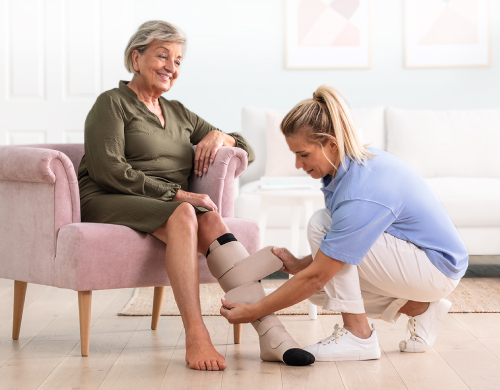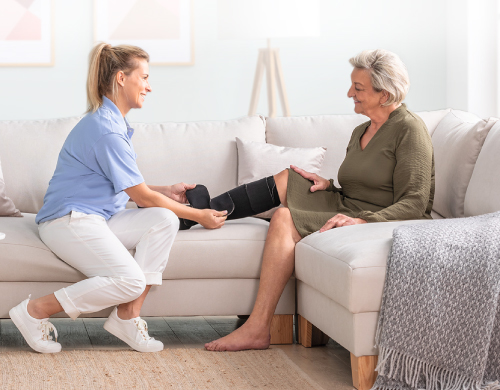What You Need to Know about Lymphedema
Lymphedema is manageable.
Regardless of the reason for your swelling, lymphedema is manageable. The size and stiffness of your arm or leg can be reduced and improved. Skin conditions related to your swelling can also improve. The use of compression garments, wrapping, specialty massage, skin care and remedial exercises can make all the difference in your lymphedema.
Lymphedema garments are often covered by insurance.
Most insurance carriers DO pay for compression garments and accessories. Ask your lymphedema therapist to send your products to an “in-network” Durable Medical Equipment (DME) provider or facility. Many insurance plans, including Medicare, cover Lymphedema medical compression garments based on medical necessity. To learn more about the new Medicare compression lymphedema benefit category (LTA), click here.
It’s important to see a lymphedema therapist and visit a clinic.
There are many lymphedema clinics throughout the country, which you can find online, via social media or through organizations such as the Lymphology Association of North America and the National Lymphedema Network, which have directories of certified lymphedema therapists in your area. Lymphedema therapists have special training in managing chronic swelling. They can stimulate lymphatics, re-route fluid and use specialized wrapping to help reduce your swelling.
You can develop lymphedema from cancer treatment, venous insufficiency and other reasons.
Lymphedema can result from anything that causes damage to the lymphatic system. If you had lymph nodes removed and/or radiation as part of your cancer treatment, your oncologist should be familiar with lymphedema and will be able to give you a proper diagnosis. Sometimes a person develops lymphedema due to congenital (or primary) malformation in the lymph system. If you are born with a malformation of the lymphatic system, you have primary lymphedema.


Lymphedema treatment includes four steps.
The gold standard for treatment of lymphedema includes four key elements: medical compression, manual lymph drainage (MLD), exercise and skin care. You should expect to see changes weekly in volume reduction. If there is significant swelling or very firm skin from swelling, it might take longer to see changes. While every facility treats lymphedema differently, there are usually four weeks of treatment, which includes preparation to manage your lymphedema on your own.
You need to be properly fitted for your medical compression garments.
Your lymphedema therapist or a certified fitter will measure you for medical compression garments. For your first fitting, wear loose-fitting clothing so you can be measured around your bare arm or leg, i.e., shorts, sleeveless shirts, etc.
Your fitting will take place in a private room and last 20-30 minutes. A certified fitter will take circumference and length measurements around your limbs requiring compression. After determining your correct sizing, your fitter will show you a variety of options for your compression garment. Today, compression products are available in many colors, materials and styles.
Once you receive your garment, your fitter/therapist can share tips that make it easier to put it on and take off. Donning gloves are very helpful. When on, look in a mirror to ensure your garment is smooth and properly fit.
Be prepared with any questions or concerns to discuss with your fitter during your appointment. With a proper fit and education, you will love your new compression garment.
If you don’t manage your swelling, your health may suffer.
Not managing your swelling can lead to significant consequences. The most obvious is that the swelling will continue to get larger and heavier. The additional weight of your limb can cause joint damage and premature wear and tear on muscles. Unmanaged swelling in your arms can cause shoulder damage. Swelling in your legs can cause balance issues. Also, swelling is not just fluid, it also contains cells, cell waste and bacteria, which can lead to infection. Once infected, swelling can increase, causing further damage to the lymph system and increase the incidence of future infections. Therapists often remind patients that not managing swelling will cause the swelling to manage you.
Be aware of risk factors for secondary lymphedema.
Heat is a factor with swelling because the body normally uses the skin as a radiator to cool itself off. When you get too hot, your body will do the natural response and send blood out to the tissues, which causes extra swelling in the tissue. While you can’t always get out of the heat, try to avoid it when possible, and wear your compression to keep your swelling in check (even during the hot summer months).
Scratches and injuries that break the skin can be a potential cause of infection. Skin is a barrier to infections. It is slightly acidic and keeps harmful bacteria out of the body. When the skin swells, it loses its acidic nature, and bacteria can increase in numbers. If your skin is injured, the fluid can become food for infection. This infection will cause further damage to the lymphatics and increase the swelling and size of the affected area.
Lack of mobility is another risk factor. Your veins are fairly passive – if the muscles are not squeezing on the veins, the blood pools in the veins and can distend them. Given enough time and pressure, the veins can be permanently damaged, causing swelling known as chronic venous insufficiency (CVI). Learn more about CVI.
Lack of compression from a garment that is too loose or old is another risk factor. It is important to follow your manufacturer’s product replacement guidelines. Typically, a garment should be replaced every six months so that the compression threads do not lose their ability to keep fluid from returning into your limb.
Poor quality or improperly fitting compression garments can be another risk factor. It is important to get measured for a sleeve or stocking that fits you and your needs. Do not borrow compression garments from anyone else to wear. You won’t know how fatigued the product is and the sizing likely isn’t proper for you. Garments that are poor fitting also tend to bind and pinch the skin. This can cause a mild tourniquet effect and increase swelling below the binding area.